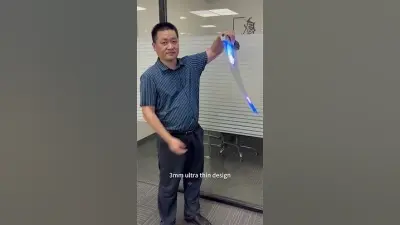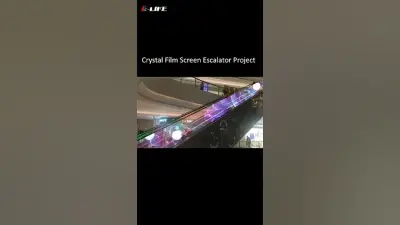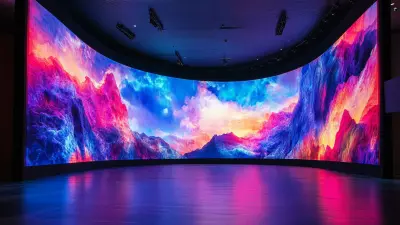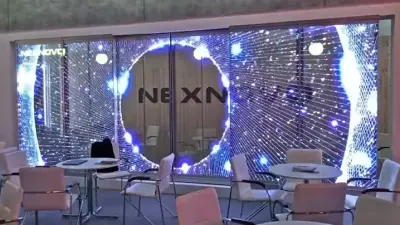
-
Home
-
Products
-
About Us
-
Case
-
News
-
FAQ
-
Contact Us
Leave Your Message

The demand for innovative display technologies has exploded in the past few years, especially in immersive surroundings where visual communication is of prime importance. The Transparent LED Underwater Screen is one of the most exciting technologies now transforming how information is presented in water bodies and is perhaps the biggest attraction in this niche at present. Reports from the industry suggest that the global underwater digital display market is slated to touch $1 billion by the year 2025, largely due to applications in aquariums, marine exhibitions, and underwater tourism. The screens not only beautify the underwater attractions but also attract audiences in a charming way with their unique blend of transparency and vivid imagery.
Shenzhen Qianhai Hengyunlian Technology Co., Ltd. is the heart and soul of this technology, with a specialization in flexible transparent LED displays and multimedia applications. The Transparent LED Underwater Screens have lots of advantages, with regard to energy efficiency, versatility in design, and the possibility of displaying brilliant visuals without obstructing the view of the underwater environment. As a consequence of more businesses and institutions recognizing the possible benefits of such displays, the future of immersing underwater experiences is looking brighter and brighter, really, an exciting time for the development of display technology.

Transparent LED technology has altered the arena of aquatic settings and offers unique advantages in many applications. The displays' extreme transparency allows for tremendous viewing enjoyment while maintaining the least interruption of the underlying surroundings. This comes especially in handy in aquatic environments, such as aquariums, where the interaction between the digital content and real marine life offers an immersive experience. With advances in Micro LED technology such as the newly launched 60-inch transparent displays, clarity and liveliness of visuals have reached a higher notch than before, and have amplified the connection of the viewer to the aquatic environment. In addition, transparent LED templates find versatility in commercial space and events and have applications on a number of aquatic possibilities. These displays can invisibly fade into the glass structure or underwater installation, all the while conveying dynamic content and respecting the surrounding cosmetic. These innovations are creating new opportunities for digital storytelling and branding as brands also look for imaginative ways to engage their customers in interactive aquatic experiences. Transparent LEDs fulfill a functional purpose and elevate the atmosphere, making them an attractive choice for architects and designers.
The Transparent LED Underwater Screens are soon going to gain momentum in the popular entertainment market, adding visuality to technology. As noted in the latest report by MarketsandMarkets, the global market for LED display would touch $27 billion by 2025; most of the demand for which will be met through transparent and immersive display technology. The progressive growth is mainly driven by the entertainment industry which asks for more and more engaging interactive installations.
One such case with these screens is the installation in aquariums and marine parks which could produce the displays underwater. On the one hand, the screens are transparent and allow the view to look through them as if gazing through water, while on the other, they can show very vivid material. For instance, the Georgia Aquarium uses transparent LED technologies to have the audience see real-time marine life with streaming artistic video content. This serves as an entertainment and education tool, bringing the audience closer to marine environments.
Cinemas and themed attractions are adopting this kind of technology to enhance real-time immersion using transparent LED screens increasingly. The prospect of complementing physical sets with digital content results in an awe-inspiring effect. According to IAAPA research, there is a 30% increase in guest satisfaction reported for theme parks with advanced display technologies, showcasing the difference transparent LED underwater screens can make in enhancing entertainment gallops.
Transparent LED underwater screens are changing the ways of displaying marine life for the public. They provide a new way of viewing by enabling visitors to appreciate exciting underwater perspectives while enjoying digital content. Traditional aquariums are, for those viewing, limiting; the transparent screens have removed boundaries by giving an impression that the digital images are an integral part of that particular environment. There is a great impact in attracting many audiences, even children and adults, to the perfect aesthetics without barriers.
This is the greatest advantage of transparent LED displays in the marine life exhibit: educating and informing. Combining some informational graphics and videos placed above the undersea scene, these screens will tell more about marine ecosystems as it relates to conservation and biodiversity. This dynamic approach to storytelling touches visitors beyond their visit and leaves a lasting impression and appreciation of marine space and its preservation.
The next plus point is these transparent LEDs can show a personalized front, which can vary with the exhibition or even the season. It is really simple for aquariums to replace what they will display to emphasize particular life forms on a specific habitat or conservation message. Thus, the visitors will have something new to view every time. Besides enhancing learning outcomes, that keeps the exhibit fresh and relevant to today's marine issues.
The introduction of transparent LED screens has brought a whole new aspect to underwater advertising. They allow high visibility while valuing aesthetics and are perfectly suited in aquariums, underwater parks, and other aquatic venues to lure audiences into the experience.
Underwater advertising is new and takes audiences to a different level. Bright, brilliant graphics, or animated advertisement, shown by transparent LED screens, would be folded directly without depriving the natural view, thus enchanting the overall experience of customers. Besides being a platform for promotional content, such technology completes the undersea aesthetic theme with natural relations to aquatic surroundings.
It can draw a multitude of tourists as well as citizens, all for its stunning visuals, while bringing underwaters into a whole new experience. It has perhaps the best capability of anchoring emotional connections between brands and target audiences by showcasing their products or services under an inviting and much more interesting environment. With such revolutionary concepts in marketing, the future capabilities of interacting with consumers by brands under water seem to be limitless.
Maintenance and durability of transparent LED underwater screens are important from optimal performance perspectives. According to a Future Market Insights report, the transparent display market will witness a CAGR of 23 percent between 2021 and 2031, which shows increasing demand for such innovative display technologies in aquatic environments.
Transparent LED screens are known for their durability, being far more reliable than the conventional screens. They are made from tough materials that can withstand high humidity and exposures to saltwater, allowing them to resist corrosion. A study by MarketsandMarkets indicated that waterproof displays can give an extraordinary long lifespan, in which many of the units are expected to last over 50,000 hours with continuous operation. The increased life of these displays decreases replacement costs and demands less maintenance, thereby serving as a cost-effective solution for the manufacturers.
The maintenance practices concerning transparent LED underwater screens assume periodic cleaning and inspection, which require little effort. Access to such screens is easy for the technicians to do on-site maintenance, enabling such maintenance without much dismantling effort. For optimal performance, industry experts recommend a bimonthly maintenance schedule upkeep to keep screens functioning properly even in heavy operating conditions underneath water. This preventive maintenance can keep the screens looking great as well as performing great, keeping audiences' sights and minds locked on.
Transparent LED underwater screens are bound to change the way we see the worlds underwater. These screens seamlessly integrate technology into nature, thus enhancing the visual environment that is capable of seducing viewers under water. They project bright images and practical moving videos that wreak havoc on an underwater photographic spectacle and provide artistic expression with functional communication. Their clear-viewing nature will give most unobstructed views of the aquatic environments wherein they'll be installed. This makes them perfect for undersea restaurants, aquariums, and other aquatic spots.
In the recent design innovations,manufacturers primarily worked on sleek and minimalist shapes, thus minimizing any visual interference that will keep nature as the focus instead of the screens. The minimalistic designs themselves become part of the environment that houses them. With the use of modern materials and advanced manufacturing processes, these LED false walls can withstand underwater conditions while providing visuals in high definition.
Meaning, customizing one's content and changing visuals at will has created endless possibilities in artistic constructs. Engage the viewer in everything from art to exhibitions on marine life and perhaps historical accounts-translucent LED underwater screens will turn every underwater experience into an interactive tale. Keeping that type of industry and art together is quite appealing, resulting in competitions that draw people while promoting educational programs. Thus, this indeed proves to be a technique that should become a part of conservation initiatives as well as greater marine awareness. With wider acceptance of these screens, it would begin revolutionizing all contacts around the defined underwater spaces, converting each into a visual feast.
Compare to normal displays, Transparent LED screens are completely new to the visual display arena. Their inherent high transparency and brightness entry into many applications like that of retail storage, exhibitions, or even entertainment. Instead of blocking views and space complexity as done by normal screens, they give seamless integration into architectural designs, helping businesses create that look and feel of correspondence in open interiors with the use of brands.
If it is anything to go by, the most recent advances in transparent LED technology are indeed indicative of the times. With recent advances in micro LED technology, it has become possible to manufacture displays with outstanding clarity and visual impact. Those, aside from being very transparent, deliver even higher resolution: thus, allowing one to enjoy viewing experience even more. Not to mention that they are lightweight, thus paving the way for ingenious installations that would have been unrealistic with the very heavy installations of the traditional displays. With more and more brands realizing the benefits of transparent screens, we will expect them to grow in the verticals; changing people's perspectives on their everyday interaction with images.
A few of their applications include the most basic advertising and information functions; they will be able to display messages directly. They can surely blend in with the surroundings, making them functional displays of information or advertisements. Excellent strengths to bring into periods of synergy and engagement between industries that would be expected to explore technology and design delivery. Transparent LED displays would be seen in very much of communicating the visual future.
The next big thing in transparent LED technology promises highly innovative design and functionality that is likely to transition aquatic applications into a new front. The report by MarketsandMarkets shows an increasing trend with projections stating that the global transparent display market is to reach $2.4 billion by 2025-the growth rate being 40.4%. This means that transparent LED screens are becoming widely accepted and integrated into an array of sectors such as entertainment, hospitality, and advertising.
In aquatic environments, people's permit visibility and aesthetics in allowing such bodies of water-aquariums, pools, or themed water parks-to enhance user engagement without obstructing any views. It has also been found that such installations with transparent LED screens in an aquatic setting increase visitors' interaction by about 30%. This can happen because these displays deliver up-to-date information and promotional or artistic visuals while blending in with the overall beauty of the water.
It goes without saying that technological advancements lead to a elongation and efficiency of perception for transparent LEDs; they are really useful for underwater placements. As reported by Technavio, transparent LEDs consume as little as 60 percent energy as compared to conventional display systems. This means a lot regarding sustainability in aquatic environments. Therefore, on one hand, transparent LEDs are keeping pace with their purpose through the redefinition of visual communication, and, on the other hand, meet global goals in state-of-the-art applications with water.
Transparent LED technology offers high transparency, allowing stunning visuals without obstructing surroundings, enhancing viewer experience, especially in aquariums where digital content interacts with live marine life.
Advancements in Micro LED technology, such as the 60-inch transparent displays, have significantly enhanced the clarity and vibrancy of visuals, deepening the viewer's connection to aquatic environments.
Transparent LED screens can be used in aquariums, commercial spaces, events, and advertising, blending seamlessly into glass structures or underwater installations while providing dynamic content.
They foster new possibilities for engaging customers through interactive aquatic experiences, enabling companies to creatively showcase their brands while enhancing overall ambiance.
These screens are used to create captivating underwater displays in aquariums and marine parks, featuring real-time marine life alongside artistic video content, which educates and entertains visitors.
Theme parks that use advanced display technologies, including transparent LED screens, report a 30% increase in guest satisfaction, highlighting their effectiveness in enhancing entertainment experiences.




